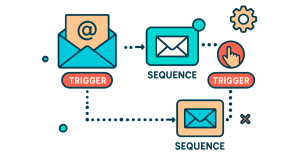There are a lot of factors working against today’s marketer. Audiences are saturated with messaging day-in and day-out. Consumers are increasingly aware and skeptical of advertisements and the data acquisition practices behind their targeting. Marketing technology solutions are constantly evolving and becoming more and more complex. On top of that, marketing professionals are being expected to take on more responsibilities at the company level as well. They’re being charged with building the brand, communicating with internal and external stakeholders, developing channel strategies, engaging with the community, driving digital transformation, and finally – generating leads for sales. And not just ANY leads, qualified leads.
Luckily, in the new age of powerful martech stacks, marketers and their sales counterparts can leverage these emerging technologies to help automate processes and work collaboratively in one of their only shared zones of respite – their CRM. Setting forth an agreed upon contact and lead scoring methodology is key for the implementation of a collaborative, cross discipline nurture program.
What Is a Contact Scoring Methodology?
Simply defined, a contact scoring methodology is the framework for applying numeric values to certain traits a contact or company in your CRM/automation tool may have. It also assigns values, both positive and negative, to actions or sets of actions a contact may take. Consider it a set of if-this-then-that statements.
Example:
If a contact signs up for your newsletter, then give them 2 points.
If a contact is an employee of your company, then deduct 10 points
Depending on what platform you utilize, that score can then be used in a number of automations, like designating a sales lifecycle stage (Marketing Qualified Lead MQL or Sales Qualified Lead SQL), Opportunity, Customer and more), triggering an email, adding a contact to a list or any number of other processes. This takes the manual nature out of nurture, but it all starts with a solid framework.
Building an Effective Contact Scoring Methodology
Outline Your Available Data
When you set out to design your methodology, you should start by auditing your technology stack and mining those tools for data that could be applicable and accessible to your platform where you’re physically doing your scoring. This could include touchpoints from your CRM, your automation tools, your customer service and support platforms, sales databases, social channels and so much more. When deciding whether a tool fits into your methodology, ask the question, “Would an interaction on this platform give me any more clarity as to whether or not a contact is any more or less viable from a business perspective?” If the answer is yes, then determine if that data can be extracted from that platform.
Automated vs. Manually Entered Scoring Attributes
Many tools have direct integrations with several other platforms, making the extraction process easy. Other times, a direct integration does not exist, but data can be passed from tool to tool by utilizing an API (application program interface). This allows tools to communicate without having a true integration. Other times, data points will need to be manually entered or tagged by sales or marketing personnel.
Examples of these types of fields may be whether a contact is connected to a sales associate on a social platform or in what manner a contact was entered into the system – be it tradeshow visit, targeted digital campaign or other means. If your model does rely on manually input data points, be sure to include a plan for ensuring data is entered accurately, and in a uniformed, timely manner.
Some ways to help ensure data consistency could include building an online form for on-the-go submission of data from outside sales and marketing teams. You might also create a spreadsheet with protected cells where the values have some sort of controls placed upon them in order to ensure clean data is being entered. Whatever method you choose to embrace, it should be done through the lens of your own organization. A system and a process are only as good as its application. Once you have identified what data points are available, the next practice is to narrow that to which data points are valuable.
The Ultimate Strategy Guide to Microsoft Dynamics and Marketing Automation
Learn how to integrate dynamics with your email, social, & more
Developing Your Attribute Categories and Attribute Endpoints
Start With a “Good Fit” Model
When you begin building out your contact scoring framework, it’s always a good idea to start with your company’s “Good Fit” model for qualifying clients. These are the foundational questions that serve to answer from whom you will or will not accept work. For some businesses, a person may need to be physically located in a particular state or region. Some businesses only deal with certain companies or individuals who have a certain annual spending threshold. Others deal only in certain industry verticals. Whatever your limitation may be, those attributes are a smart place to start. Outside of this, it can be beneficial to divide possible data points into categories. For the sake of this activity, you can begin with the following categories:
1) Attributes of a contact
2) Attributes of a contact’s company
3) Actions a contact can take
4) Actions a marketing or sales team members can take
5) Advanced Calculations or Grouped Interactions
Attributes of a Contact
This set of data points should focus on attributes of the individual you are trying to “score.” These may include things like their job title, their geographic location or how well they match one of your outlined personas. More often than not, these will be manually entered attributes.
Attributes of a Contact’s Company
This is a much larger and more nuanced set of potential attributes than other categories may be. For this group, start with a company’s industry and industry subset. Some companies rally behind Standard Industrial Classification Codes or “SIC codes” to classify their prospect industries. Both OSHA.gov and NAICS.com both have highly-regarded SIC search tools.
Other attribute types to consider deal with a company’s organizational structure. For example, if your company only deals with businesses in which there is a dedicated sales or new business team, that might be an attribute to consider. The same can be said for any type of service industry that deals specifically with internal teams with particular roles within their company. Perhaps your business deals only with brands with an average annual budget threshold, a certain number of employees or a certain amount of annual revenue. Whatever your business case may be, those attributes can and should be mapped to this category.
Actions a Contact Can Take
This step of the scoring process requires a clear picture of both a company’s marketing and sales practices, since it is comprised of signals from both sides of the communications coin. On the marketing side, an easy starting point is outlining all of the contact forms that exist on your site and determining if their submission is a signal worth accounting for.
Form Submissions
Requests for a demo or more information are always a strong signal that a contact is moving along their journey towards conversion. Other form submissions might have less of an implication of sales readiness than these but are still worth considering for the sake of scoring. Examples of these can be newsletter signups, usage of various online tools like calculators or branch/location locators, quizzes, surveys and more. While it may be true that their simple submission of these forms may not be an indicator of “good fit,” the data submitted may. A user may self-identify their regional location by searching for a nearby resource like an ATM, a retail location or other local entity. They may identify as someone who fits your persona by way of their survey or quiz answers. A wealth of information and qualifying data points can be derived from form data – as long as it is being used in a privacy-conscious and responsible manner.
Email Activity
Email plays a major part of most, if not all, automation programs. User signals like email subscription status and preferences, opens, clicks and the frequency/recency of these actions are all strong data points to which you can apply scores. Beyond this, sophisticated email and automation platforms allow users to send both marketing emails as well as sales emails that appear to be sent from an individual within a company. Encouraging replies to and interaction with these types of emails can be another strong way qualify a contact and enhance their score and profile.
Worth noting, your email program can be one of the quickest ways to gain more insights about your contacts who also happen to be subscribers. Statista states that more than 1/3 of email marketing subscribers enjoy being invited to participate in surveys as a category of email content. So if you’re lacking a data point to differentiate your contacts’ needs, just ask for it!
Content Engagement
What content a contact engages with and the frequency of those engagements can be strong indicators of their need states and sales-readiness. Whether your individual indicators include blog views, whitepaper or other lead magnet downloads, webinar attendance, case study views or otherwise, each engagement builds a wealth of actionable data for your contact profiles. Even interactions with a tightly targeted ad campaign can be a signal of intent or customer status if built correctly.
The best part of this set of attributes is the fact that tracking for most of them can be automated. The level of effort and the available data points depend on your technology stack, but most major platforms provide a level of integration with these types of data.
Actions a Marketing or Sales Team Member Can Take
Now comes the tricky part. While the majority of the activities in this section of attributes largely require manual updating, they can be some of the most impactful and informative data points for your model. This is a way to gain visibility into your direct outreach methods and qualify those activities. Whether it’s mailing a hand-written card, sending a capabilities deck, conducting an introductory phone call or any other manual touchpoint, recording these interactions and how/if the contact responds to them can be very informative for your measurement efforts.
Advanced Calculations or Grouped Interactions
Now that you’ve hopefully got a clear picture of each of your individual data points that can make up your contact scoring framework, you can start to take a look at if and how the interplay between them can be translated as a strong signal of intent.
Let’s use the example of a local bank looking to qualify those in need of business banking services. In this scenario, one contact has subscribed to their business finance newsletter, visited a Commercial Loans product page, and viewed a business banking case study. While these actions on their own would certainly not indicate readiness for outreach, their grouped interactions indicate a need state and high engagement. While immediate outreach may not be the next step, that set of actions should merit its own point value if your platform allows it.
These “interaction bundles” should be specific to your business, but their value cannot be overstated. This is where traffic and behavior transitions to action and intent.
Assigning Scores & Testing Your Model
Assigning Scores
Now that you’ve broken down your platforms into available data points and those data points have been mapped to contact attributes, it’s time to assign values to those attributes.
Ranking in Terms of Impact
Before you begin the process of building your overall scoring rubric, start by assigning “impact scores” to your attributes. If you have a large number of attributes, assign them a range of 1-5. Use the range 1-3 for a smaller set of total attributes. The smaller range for smaller sets will help you have more substantial scores to test your model when the time comes. This ranking activity should be done collaboratively with the sales and marketing teams, as a strong indicator for one may not ring true for the other. After this activity is complete, sort your attributes by impact rankings and review them for accuracy. Sometimes doing this activity first by category and then by “all attributes” can be helpful to help frame the thought exercise.
From that point, take a look at your overall breakdown of “priorities” and identify whether or not they should truly be as high or as low as they are. One thing to keep in mind is, if everything is a 5 then nothing is a 5, so use those scores sparingly.
Assign Initial Scores
For some, the output of the 1-3/1-5 activity may act as their ultimate scoring model. For others, the formula may need a little more refining. Scores assign to attributes like pageviews, email opens and other low-level engagements should be assigned values that allow them to meaningfully accumulate over time. While this is true, consider the scenario in which a user performs many low-level engagements and how those in aggregate would stack up against a high-level engagement signal like a request for a demo or for more information. With this in mind, set thresholds sparingly and grant higher scores conservatively when it comes to individual attribute scores.
Test and Test Again
Calculate Your Max Score
After you are confident in your point values, add up all of the possible points a single contact could theoretically accumulate and record that number. From there, test several theoretical journeys that a user could fulfill and find those numbers. With these numbers recorded you should now have a fairly strong idea of what adjustments to your scores should be made. If you’re still unclear, there are other ways to test your scoring rubric.
Retroactive Scoring
Realistically, no contact would likely ever reach your maximum score. So how can we calculate what a likely score ceiling should be expected? Some CRM and automation tools begin applying scores to actions taken after the rubric is published. Others can retroactively apply points to actions that a known contact has taken in the past. If your platform allows for the latter, you’re in luck. Implement your scoring rubric, publish it and review the scores applied to your contacts. Do you have several contacts achieving higher than expected scores? That would indicate a need for adjustment of values of actions or thresholds of accumulated action values. On the other hand, if there are low scores across the board, perhaps your expectation of your users’ journey might be a little skewed, requiring realignment around realistic engagement expectations.
One way to test your rubric with some certainty, as long as your platform allows for retroactive scoring, is to review the scores of some of your known existing or past customers. Locate them in your CRM and review their scores as well as the actions that contributed to those scores. What are some commonalities between them? Is there overlap in their paths? Are their cumulative scores higher or lower than you expected? These numbers can act as a good starting point for adjusting your scores and establishing thresholds for Marketing Qualified Leads and Sales Qualified Leads.
It may sound obvious, but it bears restating. If you set your thresholds too high, your volume of leads delivered to the sales team will be low. If you set your thresholds too low, your lead volume may be overwhelming for your sales team or the true value of those leads could be lacking. Over time, through the participation of both teams, your overall scoring model will be refined and align with the expectations of the full team.
Test MQL and SQL Thresholds
After your scores are live and accumulating as a result of real-world scenarios, sales and marketing teams should work together to review contacts with varying lead scores and measure their true values as an MQL or SQL. By evaluating the scores of a cross section of contacts and their activity that has resulted in those scores, the teams can review whether or not that score would indicate a good fit for the MQL or SQL label. If not, revisit and refine the formula. If so, revisit and refine the formula anyway. A proper contact scoring methodology is always a work in progress and should not be expected to run on auto pilot. It takes maintenance, updating and future testing in order to perform to its fullest.
Throughout this activity, you will not only have created what is hopefully a vital tool in measuring contact performance for years to come, but you’ll also have strengthened the relationship between the marketing and sales department, an alignment that will result in increased efficiency, cooperation and most of all, profitability.


